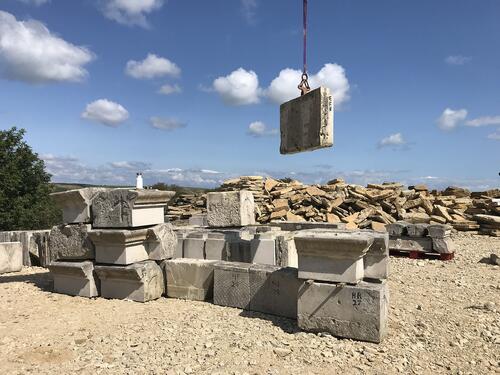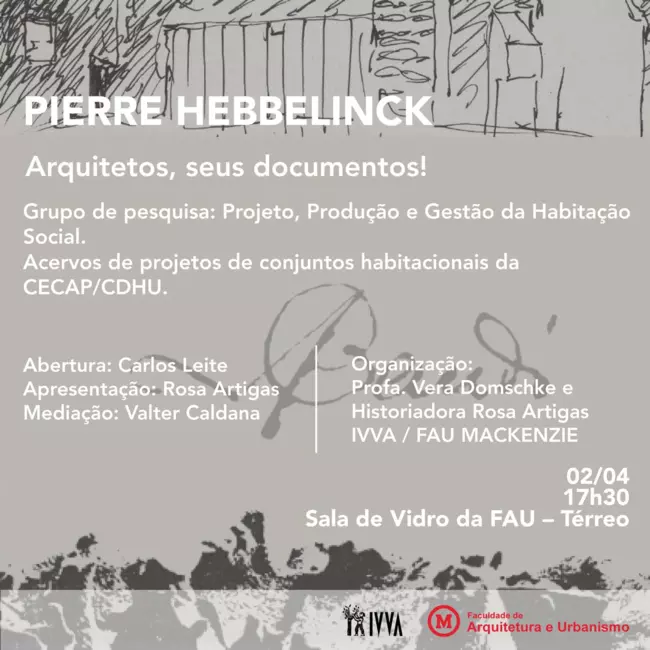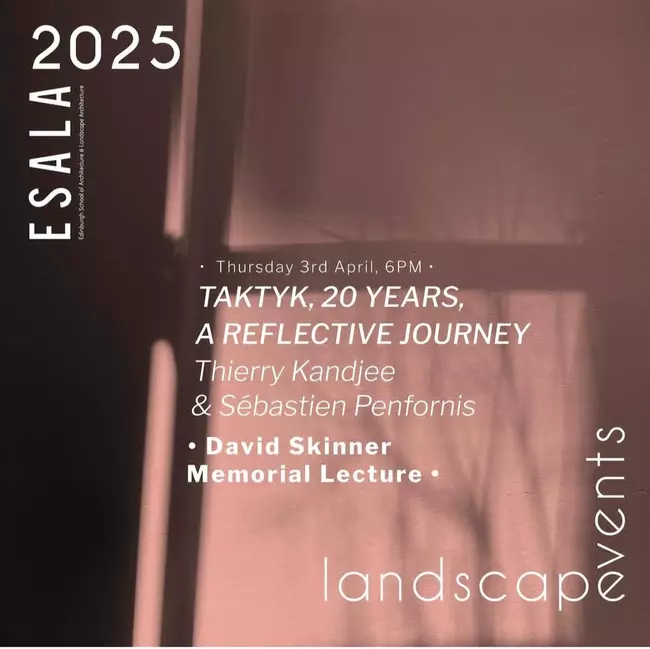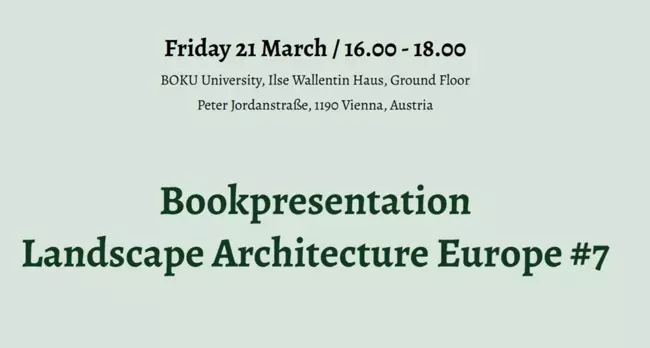- News
Published on 27/01/2022
Symposium "(Re)building with Stone" at Architectural Association

© Juliet Haysom In a quarry of silences.
The people of the city heard it.
They hunted the stones, taciturn and separate,
…
A workman walks by carrying a pink torso.
The storerooms are full of hearts.
This is the city of spare parts.
(Sylvia Plath, The Stones, 1959)
Portland limestone, red ruby granite, tuff, travertine: from prehistoric cataclysmic events to perpetual sedimentations, cured for millions of years underground and laboriously extracted from the depth, manually or mechanically shaped and dressed, becomes a building product which is generically called “natural stone”.
This primitive structural material is the essence of architectural tectonics, but stone has culturally eroded to become merely a consumable and interchangeable ornamental surface. Larvakite granite is now Blue Pearl granite, as the geological appellation has given way to commercial branding. Sourcing colour specific stone from across the globe adds (sometimes doubles) to the embedded energy in extracting it locally. Although architectural history is a testimony of stone reuses and perennity, yesterday’s spolias have now become obsolete ponderous ashlars or single-use, frost-sensitive, micro-fissured claddings. Salvaged stone components are slow and costly to transport, store and recirculate within today's paradigm and are now systematically crushed as aggregates.
The first part of the symposium will uncover the embedded geological, structural and cultural values of stone and reflect on the craftsmanship and human toll involved in ‘first-hand’ stone extraction. The second part will pave the way for future salvaging practices and long term structural potential. Finally, the discussions will expand towards the ambitions for material recirculation at the city scale.
Schedule:
10.30am
Welcome11am
Building with Stone: Nature, Culture and Structures
presentations by Simon Barker, Thibaut Barrault & Michael Ghyoot with respondent Ruth Siddall
moderated by Juliet Haysom2 pm
Rebuilding with Stone: Bottlenecks and Resurgent Practices
presentations by Lionel Devlieger & Robert Greer with respondents Valerie Vermandel & Adam Hills
moderated by Aude-Line Duliere3:30 pm
Recirculating Stone: Policy, Tools and Perspectives
Presentations by Michael Ghyoot & Ele Mun with respondents Ans Persoons, Gaetan Danneels and all symposium contributors
moderated by James WestcottParticipants:
Simon Barker is an archaeologist with a DPhil in Classical Archaeology from the University of Oxford. His doctoral dissertation, finished in 2011, was entitledDemolition, salvage and re-use in the City of Rome, 100 BC - AD 315. He has since held several postdoctoral positions throughout Europe, including a Postdoctoral fellowship in Classical Archaeology at the Norwegian Institute in Rome and an Alexander von Humboldt fellowship at Ludwig-Maximilians-Universität München and Universität Heidelberg. His research focuses on a variety of aspects related to the ancient world, including the production and supply of materials for construction in the Roman period; ancient stone-working techniques; spolia in the late antique and mediaeval periods; and the use of historical records and nineteenth-century building manuals in Roman architectural studies.
Thibaut Barrault is the cofounder with Cyril Pressacco of the Paris-based architectural practice Barrault Pressacco which activity is shared between urban projects and metropolitan strategies, buildings conception and construction, research and teaching. Barrault Pressacco have completed several housing buildings in load-bearing stone. Thibaut graduated from the Paris-Est School of Architecture where he teaches today and worked in Paris, Rotterdam and Buenos Aires.
Gaetan Danneels is the Representative of the Secretary of State of the Brussels-Capital Region, Barbara Trachte responsible for Economic Transition and Scientific Research.
Lionel Devlieger trained as an architect and engineer in Ghent and Rome. While setting up practice as an independent marble craftsman-contractor, Lionel co-founded Rotor (2005), a research and consultancy group established in Brussels promoting building materials reuse and circular strategies. Within Rotor, Lionel managed design, research, exhibition and consultancy projects. He obtained his PhD in architectural history and theory from Ghent University in 2005 where he now teaches as Associate Professor in 'Cultural and Material History of Architectural Practice'.
Aude-Line Duliere is an architect, researcher and educator. She co-runs a studio in collaboration with the Brussels-based cooperative Rotor at the AA with a focus on material reuse. She manages academic, cultural and built projects that consider our relationship to resources, labour and supply systems. Aude-Line studied in Brussels at La Cambre and Sint-Lucas (KU Leuven), holds a Master of Architecture degree from the Harvard Graduate School of Design, and worked at David Chipperfield Architects between 2010-15.
Michael Ghyoot joined Rotor in 2008. Michael has been coordinating the FCRBE project led by Rotor and carried out by a partnership of 11 organisations as part of the Interreg NWE programme. The project aims at fostering the reuse of building materials in North West Europe through the development of guidance documents, the documentation of the existing reclamation industry and various communication efforts. Michael also co-wrote and edited the bookDéconstruction et réemploipublished in 2018. Michael trained as an architect and researcher in Brussels and obtained a PhD in architecture in 2014 from the ULB.
Robert Greer is a Director at PAYE Stonework and Restoration which is one of the country’s largest and longest established companies in the heritage sector, specialising in historic façades, monuments and other important structures. Robert Greer joined the company in 1996 from a main contracting background. He has over thirty years experience and was responsible for the company’s projects at the Royal Opera House, BBC Broadcasting House, Royal Albert Hall and The Tower of London. Robert is also responsible for implementing the Environmental Policy and the training of skilled craftsmen.
Juliet Haysom has trained in Fine Art at The Ruskin School, University of Oxford and the RCA, later completing RIBA Part 1 at the AA. As an artist, she has produced several site-specific projects with a geological focus, working with locally-quarried limestone within a restored Victorian cliff-side park in Torquay, Devon, and with chalk excavated from within a new public garden in Amesbury, Wiltshire. Juliet’s family run a quarry and masonry works in Purbeck, Dorset, and she is keen to develop teaching opportunities to introduce students to stone, its associated workshop processes, and its potential as a contemporary architectural material. She is also interested in drawing, and its practical application in mediating an exchange between designers and makers. Her drawings are held in the collections of the British Museum and the V&A.
Adam Hills is the founder, with Maria Speake, of Retrouvius. Retrouvius started in Glasgow as a vehicle for working with the conservation world and local demolition firms. Today based in West London, Retrouvius continues to champion the re-use of salvaged material, alongside a broad approach to sustainability, turning respectfully re-used materials to distinctive, contemporary ends. Overseen by Adam, the Harrow Road warehouse provides a refuge for an everchanging stock — ranging from tropical hardwoods, architectural elements, eye-catching one-offs, rugs and lighting.
Ele Mun is a Malaysian architectural designer and (very) occasional filmmaker based in London. During his final year at the Architectural Association, he had proposed a strategic re-organisation of building resources at a regional scale, making salvage and reuse practises more viable for demolition contractors, architects, and building owners alike. After graduation, he worked on a documentary for the exhibition, ‘Placeholders’, as part of the London Design Festival at the V&A. He is now an architectural assistant at David Chipperfield Architects.
Ans Persoons is deputy mayor in the City of Brussels, in charge of urban planning & public space. In her role as chair of the planning permissions committee, she has often been confronted with questions regarding demolition/renovation and how to reuse building material. Her main preoccupations are affordable living for all and how to adapt the city of Brussels to climate change, not only in its building policy but also by rethinking public space.
Ruth Siddall is a geologist based at UCL. She is a field- and a lab-based scientist with academic research interests in mineralogy applied within the cross-disciplinary and broad research themes of cultural heritage. She also has a specialist interest in the provenance of stone used in art and architecture and on the relationships between Earth sciences and the built environment – urban geology. She also co-developed the London Pavement Geology website and App which archives building stones used in London and the wider UK.
Valérie Vermandel is head of the project development branch of Whitewood. She is an engineer-architect with an additional degree in conservation of monuments and sites (KULeuven) as well as an Executive MBA (Vlerick). After working a few years as an architect in the field of renovation and transformation of historic monuments, she decided to settle herself at the other side of the table, representing the owners. Convinced that in this position strategic decisions can be taken to change the way we see construction and development, she aims to define and settle clear sustainability goals on each project.
James Westcott is co-tutor with Aude-Line Duliere of Diploma 18, a unit focused on material reuse, and tutor of a seminar on conservation strategies, at the Architectural Association. He is editor-in-chief ofCountryside: A Report,Elements of Architecture, co-editor ofProject Japan, and author of When Marina Abramovic Dies: A Biography. He taught at TU Delft in the Netherlands. His writing has appeared in AA Files, Aeon, the Guardian, the New York Times, salon.com, Open Democracy, Alternet, among other places. His research focuses on material flows and reuse; media and story; ecology and conservation strategies; activism and civil disobedience; the Neolithic and domestication; the countryside.
An exhibition in the gallery will accompany the symposium.
- ActualitésDate de l'événement
03/04/2025Published on 21/03/2025
-
TAKTYK à EDINBURGH COLLEGE OF ARTS
Chaque année, la Conférence commémorative David Skinner rend hommage à un cabinet ou un praticien reconnu en architecture de paysage, dont le travail [...]Conférence
- Actualités
Published on 21/03/2025
-
TAKTYK à Vienne
Le 20 mars à 16 heures, Boku University accueille la présentation du livre Landscape Architecture Europe. A cette occasion Taktyk Brussels-Tropics [...]Book launch Landscape Architecture Europe#7




